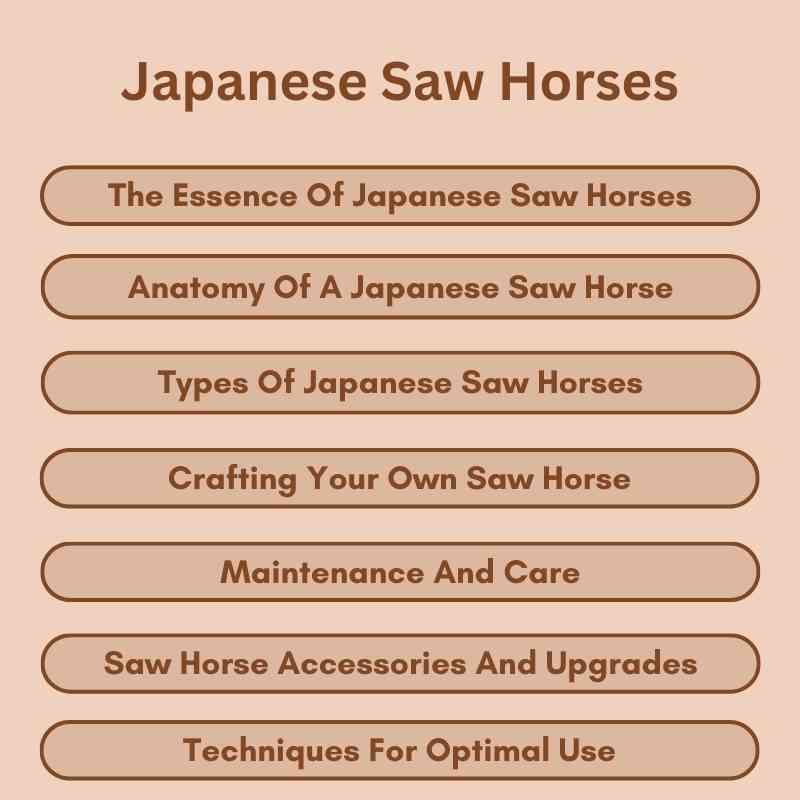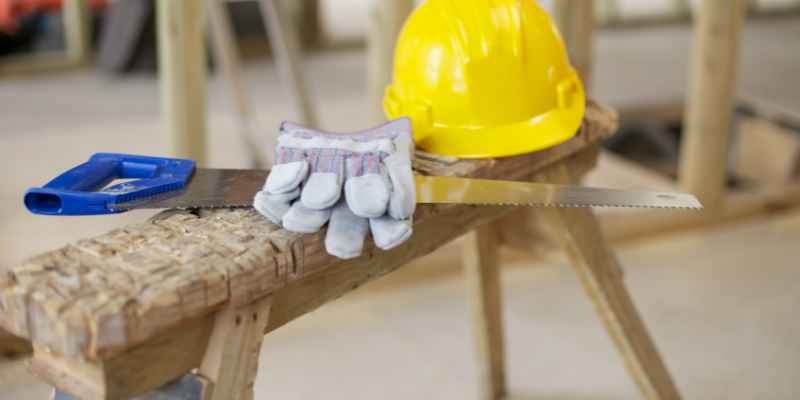Japanese saw horses are sturdy supports used in woodworking and construction. They provide stability for cutting and assembling materials.
Japanese saw horses, or “sawhorses,” are essential tools for carpenters and DIY enthusiasts alike. Originating from Japan, these sawhorses combine traditional craftsmanship with modern design. They offer robust support while being lightweight and easy to maneuver. Their unique structure allows for efficient use of space, making them ideal for small workshops.
Many woodworkers appreciate their versatility, as they can be adjusted for various tasks. This practicality extends to outdoor projects as well, where portability is key. Whether you’re cutting lumber or crafting furniture, Japanese saw horses enhance precision and safety, making them a must-have in any toolkit.
The Essence Of Japanese Saw Horses
Japanese saw horses are more than just tools. They represent a deep understanding of craftsmanship. Their design and functionality are rooted in tradition and precision. These saw horses enhance the woodworking experience.
Traditional Design Elements
Japanese saw horses feature unique design elements. They are often made from wood, showcasing natural beauty. Here are key characteristics:
- Simplicity: Clean lines and minimalistic design.
- Lightweight: Easy to move and set up.
- Stability: Wide stance ensures balance.
- Adjustability: Height can vary for different tasks.
These design elements create a harmonious balance. They reflect the philosophy of Japanese craftsmanship.
Role In Precision Woodworking
Japanese saw horses play a vital role in woodworking. They provide a stable platform for cutting and shaping wood. This stability ensures accurate measurements and clean cuts. Here are ways they contribute:
- Support large materials securely.
- Facilitate easy access from all angles.
- Enhance safety during cutting tasks.
Using a Japanese saw horse promotes precision. Craftsmen appreciate their ability to improve workflow.
| Feature | Benefit |
|---|---|
| Lightweight | Easy to transport and store. |
| Stable design | Reduces risk of accidents. |
| Adjustable height | Accommodates various tasks. |
In summary, Japanese saw horses embody tradition and precision. They are essential tools for serious woodworkers.

Anatomy Of A Japanese Saw Horse
The Japanese saw horse is a unique tool. Its design enhances woodworking. Understanding its anatomy helps in effective use. This section covers key features, measurements, and materials.
Key Features And Measurements
Japanese saw horses stand out due to their design. Here are some key features:
- Height: Typically around 30 inches.
- Width: Usually about 18-24 inches.
- Weight Capacity: Can support up to 1,000 pounds.
- Foldable: Easy to store and transport.
- Stable Base: Offers great balance on uneven surfaces.
Measurements may vary slightly based on the model. Always check the specifications before purchase.
Materials Commonly Used
Japanese saw horses use various materials. Each contributes to durability and functionality:
| Material | Advantages |
|---|---|
| Wood | Strong and traditional look. |
| Metal | Highly durable and resistant to wear. |
| Plastic | Lightweight and easy to clean. |
Wood remains the favorite for traditionalists. Metal and plastic options appeal to modern users.
Types Of Japanese Saw Horses
Japanese saw horses come in various styles. Each type serves unique purposes. Understanding these types can enhance your woodworking experience.
Kumiko Horse
The Kumiko horse is a traditional Japanese design. It features intricate joinery techniques. This horse is lightweight yet sturdy. It is perfect for delicate projects.
- Design: Elegant and artistic
- Weight: Lightweight for easy transport
- Use: Ideal for fine woodworking
Beam Horse
The beam horse is robust and stable. It supports larger materials easily. Craftsmen often use it for heavy beams.
| Feature | Description |
|---|---|
| Stability | Holds heavy loads securely |
| Height | Designed for taller projects |
| Versatility | Useful for multiple woodworking tasks |
Adjustable Saw Horses
Adjustable saw horses offer flexibility. Users can change the height as needed. This feature suits various projects and materials.
- Easy to set up and take down.
- Perfect for DIY projects.
- Enhances workspace efficiency.
Each type of Japanese saw horse serves its purpose. Choose one based on your project needs.
Crafting Your Own Saw Horse
Building a Japanese saw horse can be rewarding. It enhances your woodworking skills. Plus, it provides a sturdy workspace. This guide helps you create one easily.
Tools And Materials Needed
Gather the right tools and materials before starting your project. Here’s a list to help you:
| Tools | Materials |
|---|---|
| Measuring tape | Wood (2×4 or 2×6) |
| Hand saw | Wood glue |
| Drill | Wood screws |
| Screwdriver | Sandpaper |
| Clamps | Varnish (optional) |
Step-by-step Construction Guide
Follow these simple steps to build your saw horse:
- Measure and Cut: Cut two pieces of wood to the desired height.
- Base Construction: Cut four pieces for the base. These should be shorter than the height pieces.
- Join the Base: Attach the base pieces to the height pieces using wood glue and screws.
- Stabilize: Add diagonal braces for extra support. Use screws for a tight fit.
- Sand: Smooth all edges with sandpaper. This prevents splinters.
- Finish: Apply varnish for protection. Let it dry completely.
Enjoy your new Japanese saw horse. It’s perfect for your woodworking projects.
Maintenance And Care
Proper maintenance keeps your Japanese saw horses in great shape. Regular care enhances their performance and extends their lifespan. Follow these tips for easy upkeep.
Routine Upkeep Tips
- Clean Regularly: Wipe down surfaces after each use. Use a damp cloth.
- Check for Damage: Inspect for cracks or chips. Fix them immediately.
- Store Properly: Keep saw horses in a dry place. Avoid exposure to moisture.
- Lubricate Hinges: Apply lubricant to moving parts. This prevents rust.
- Use Protective Coating: Consider applying a finish. This adds a protective layer.
Longevity Practices
Follow these practices to enhance durability:
| Practice | Description |
|---|---|
| Choose Quality Materials | Invest in high-quality saw horses. They last longer and perform better. |
| Limit Weight Capacity | Do not exceed the weight limit. This avoids structural damage. |
| Rotate Usage | Alternate saw horses during projects. This prevents uneven wear. |
| Avoid Overexposure | Keep saw horses out of direct sunlight. UV rays can weaken materials. |
| Perform Seasonal Checks | Inspect saw horses every season. Look for signs of wear. |
Implementing these tips ensures your Japanese saw horses last for years. Regular attention leads to reliable performance during your projects.
Saw Horse Accessories And Upgrades
Enhancing your Japanese saw horse can boost its functionality and versatility. Accessories and upgrades can make your tasks easier and more efficient. Explore various options that can elevate your woodworking experience.
Attachments For Enhanced Functionality
Attachments can transform your saw horse into a multi-functional tool. Here are some popular options:
- Work Surface: A sturdy plywood top can increase workspace.
- Clamps: Adjustable clamps hold materials securely.
- Tool Holders: Keep tools organized and within reach.
- Leg Extensions: Adjust height for different projects.
- Cross Braces: Provide extra stability for heavier loads.
Customization Ideas
Personalizing your saw horse can reflect your style. Here are some creative ideas:
- Paint: Use bright colors for visibility and fun.
- Stickers: Add decals to showcase your personality.
- Storage Solutions: Attach bins for easy access to supplies.
- Non-Slip Feet: Enhance safety with rubber grips.
- Adjustable Height: Modify legs for different projects.
Upgrade your saw horse today. Enjoy a more efficient and personalized woodworking experience!
Techniques For Optimal Use
Using Japanese saw horses effectively enhances your woodworking experience. Proper techniques ensure safety and precision. Focus on stance, positioning, and sawing methods.
Proper Stance And Positioning
Your stance is crucial for balance and control. Follow these tips:
- Stand with feet shoulder-width apart.
- Keep your knees slightly bent.
- Position your body close to the workpiece.
- Align your shoulders with the saw blade.
Maintain a firm grip on the saw. This enhances control. Your elbows should stay close to your body. This helps in reducing strain.
Sawing Precision Tips
Precision is key for clean cuts. Use these techniques:
- Mark your cut line clearly.
- Start with a slow, steady motion.
- Apply even pressure throughout the cut.
- Use the entire length of the saw blade.
Saw Horses In Japanese Woodworking Culture
Saw horses play a vital role in Japanese woodworking. They are not just tools; they represent a rich tradition. The design and use of saw horses reflect the culture’s commitment to craftsmanship. Let’s explore their historical significance and modern-day applications.
Historical Significance
Japanese saw horses, known as “saw horses” or “saw-betsu,” have a long history. They date back to ancient times. Craftsmen used them for various tasks, like sawing and shaping wood.
- Woodworking dates back over a thousand years.
- These horses are often made from local materials.
- They embody the philosophy of simplicity and functionality.
Traditional saw horses are lightweight and portable. This makes them easy to carry around. Craftsmen often create them by hand, showcasing their skills.
Modern-day Applications
Today, saw horses remain popular among woodworkers. They are used in various settings, from workshops to home projects. Their design has evolved but retains traditional elements.
| Type of Saw Horse | Material | Uses |
|---|---|---|
| Traditional | Wood | Fine woodworking, sawing |
| Portable | Aluminum | Job sites, outdoor work |
| Heavy-duty | Steel | Construction, framing |
Woodworkers value these saw horses for their stability and versatility. Many craftsmen customize their saw horses. This allows for unique designs suited to specific tasks.

Frequently Asked Questions
What Are Japanese Saw Horses?
Japanese saw horses are traditional woodworking supports. They are designed to hold materials securely while cutting or sawing. Typically lightweight and portable, these sawhorses are made from wood or metal. Their unique design allows for easy storage and transport, making them ideal for both professionals and DIY enthusiasts.
How Do I Use Japanese Saw Horses?
Using Japanese saw horses is simple and efficient. First, set them at a comfortable height for your project. Place your material securely on top. Ensure it’s stable before cutting. This setup provides excellent support, allowing for precise and safe cutting.
Always check the stability before beginning any work.
Are Japanese Saw Horses Adjustable?
Many Japanese saw horses come with adjustable features. This allows users to modify the height and width according to their needs. Adjustable sawhorses provide versatility for various projects. This makes them suitable for different types of materials and cutting tasks.
Always check the specifications before purchase.
Where Can I Buy Japanese Saw Horses?
You can buy Japanese saw horses at various retailers. Local hardware stores often carry them, as well as specialty woodworking shops. Online marketplaces like Amazon also offer a wide selection. Always compare prices and read reviews to ensure quality. Look for options that fit your specific needs.
Conclusion
Japanese saw horses are essential tools for any woodworker or DIY enthusiast. Their design offers stability and versatility for various projects. Investing in quality saw horses can enhance your workflow and improve your results. Embrace the craftsmanship of Japanese saw horses and elevate your woodworking experience today.

